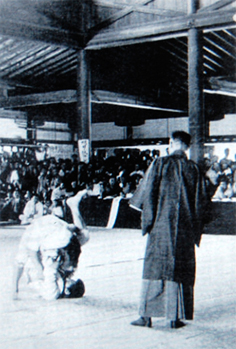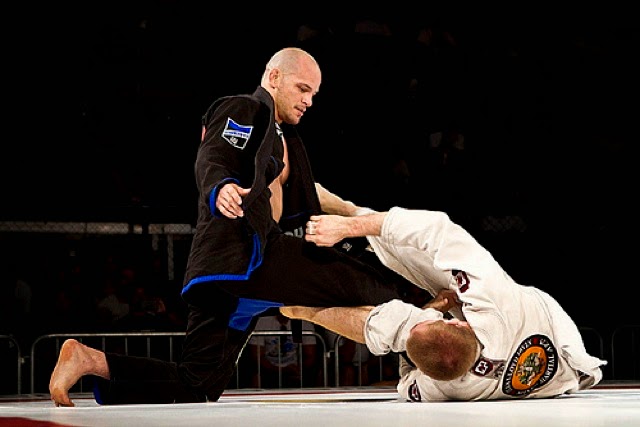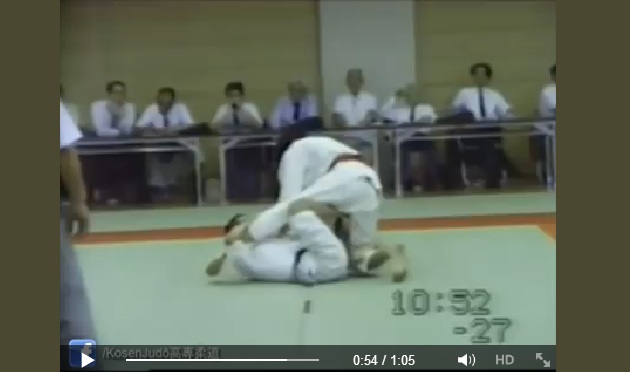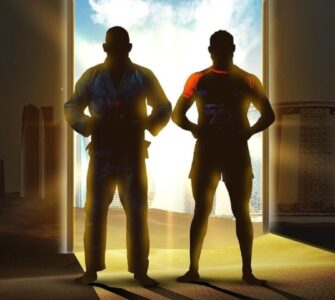The x-guard is an open guard where one of the combatants is standing up and the other is on their back. The bottom combatant uses the legs to entangle one of the opponent’s legs, which creates opportunities for powerful sweeps. The x-guard is often used in combination with butterfly and half guard. In a grappling match, this is an advantageous position for the bottom combatant, but in general hand-to-hand combat, the top combatant can attack with stomps or soccer kicks. Likewise, skilled use of the x-guard can prevent the opponent from attempting a kick, or throw them off balance should they raise a leg. The x-guard was popularised by Marcelo Garcia.
Many BJJ players wrongly believe that X guard is a BJJ specific move, but it has been used in Judo (especially Kosen Judo) for years even before Marcelo Garcia brought it to the attention of the world (early 200’s). Just like many techniques that seem to be have been recently invited, we can never be sure that other martial artists in the past weren’t doing the exact same move.

In the first video we can see the judoka of U.Nagoya of Kosen Judo, demonstrate a position that looks like X guard from BJJ, under the supervision of Shihan Mitsunosuke Kosaka. However that exists in Nanatei-Judo and is similar to the BJJ guard, as we see in the last two videos:
2nd Video: Tournament Nanatei-Judo 1988
3rd Video: Tournament with rules of Nanatei-Judo 2008.
Many of these ground techniques were used in Kosen Judo.
View this post on Instagram
What is/was Kosen Judo?
Kosen judo was a refinement of Kodokan Judo that was developed and flourished at the Kōtō senmon gakkō technical colleges in Japan in the first half of the twentieth century. Kosen judo’s competition rules allowed for greater emphasis of ne-waza ( ground techniques) than in mainstream judo and it is sometimes regarded as a distinct style of judo. Today, the term “Kosen judo” is frequently used to refer to the competition ruleset associated with it that allows for extended ne-waza. Such competition rules are still used in the shichitei jūdō / nanatei jūdō competitions held annually between the seven former Imperial universities.
Differently to modern Judo rules leglocks were allowed (Leglocks started being prohibited by Kodokan rules in 1914 in shiai and randori as well. By 1925 all joint-locks except elbow locks were totally prohibited together with neck cranks. Kosen rules being the Kodokan rules derivative did not allow leglocks absolutely).

The matches had no time limit and were usually contested on a mat 20×20 meters in total size. A starting zone 8×8 meters was marked on the mat as well as a danger zone which ended at 16×16 Meters.
There has been a limited resurgence in interest in Kosen judo in recent years due to its similarities with Brazilian jiu jitsu but it is still nowhere as popular as modern Kodokan Judo.
How is Kosen Judo different or similar to Brazilian Jiu-Jitsu?
If you look at the Kosen Judo video below you can see many moves and flows that are different from modern Judo ground work (which is much more focused on pinning and more static). These videos were made in the 1970’s by 6 older judokas , among them (in the tapes) was the famous Masahiko Kimura himself (who beat Helio Gracie). When you look at the techniques displayed in the video, it looks very similar to Gracie Jiu-Jitsu (which is more focused on the basics than modern sport BJJ). Kosen Judo players also pulled guard in competition. Kosen had a pinning rule. Strategy is different than BJJ. There was more more turtling than BJJ etc.
Maeda, who taught Carlos Gracie old style Judo (Jiu-Jitsu) but not necessarily Kosen Judo, had learned some catch wrestling in the USA on his way to Brazil, so his style had some catch wrestling elements. You can say that Gracie Jiu-Jitsu had some catch wrestling to it, that Kosen Judo never had.
Modern sport Jiu-Jitsu has all the newer innovation such as 50/50, berimbolo, De la riva guard, reverse de la riva guard, kiss of the dragon, lapel guard, worm guard, inverted guard, tornado guard etc.. There are some positions and techniques that both styles share (The spider guard for example) but the general form of grappling is more a distinct flow instead of just a collection of moves. To give you an example, look at the way Keenan Cornelius, Miyao brothers or Mendes brothers roll and then look at the Kosen Judo players in the video below. It looks much more similar to Gracie Jiu-Jitsu than to modern sport BJJ.

In short, Kosen Judo and Brazilian (Gracie) Jiu-Jitsu are similar but are still very different. Most of the techniques are the same, the competition rules are different. Kosen Judo has faded due to the popularity of modern Kodokan Judo (more focused on throws), while BJJ is fastly growing and always evolving with new techniques and flows.

















